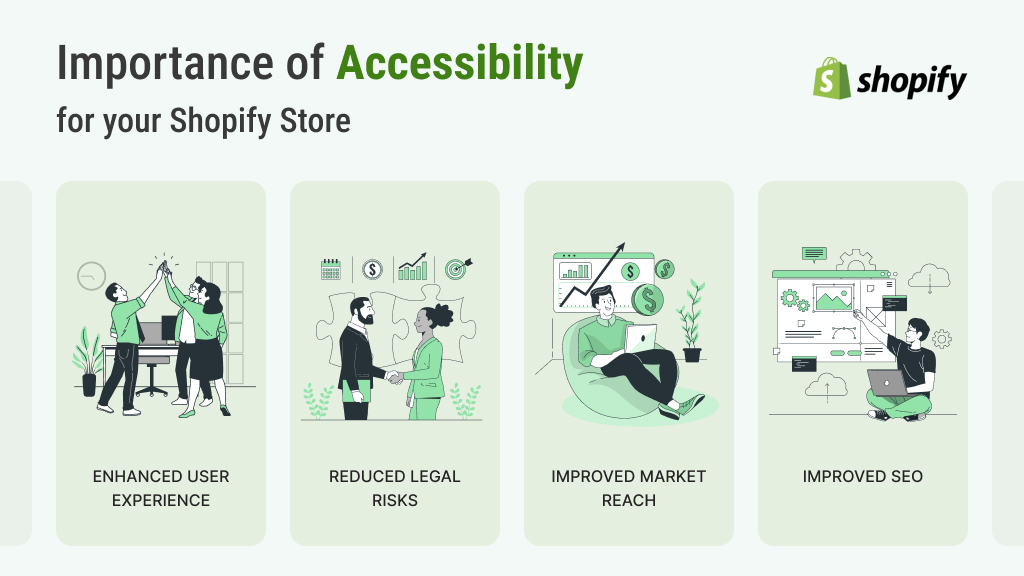Making your Shopify website ADA-compliant doesn’t need to be complicated and you don’t need to delve into the code of your site either.
Not only does Shopify have several built-in accessibility features and tools, but there are other third-party solutions available to simplify this process, too.
| Existing Customers |     |     |
| Technology | Fully automated web accessibility solution | Fully automated web accessibility solution |
| Compliant in Countries | ||
| Compliance | WCAG | ADA | AODA | Section 508 | EAA | WCAG | ADA | AODA | Section 508 | EAA |
| Prices | Starts at From $49 | Starts at From $49 |
| Partner Program (for Web Agencies) |
|
|
| Customer support | Chat & Email Support | Chat & Email Support |
| Free Demo |
Yes Free demo available |
Yes Free demo available |
| Free Trial |
No credit card needed 7-day free trial |
Credit card required 7-day free trial |
One of the main goals of accessibility is to create platforms, services, and online environments that are easier to access, use, and understand. Disabled users can’t always navigate a website in the same way that anyone else can, which is a frustrating experience if a site is not ADA compliant. Moreover, you may be missing out on business from disabled users!
By making your Shopify site accessible, you are ensuring that every user has the best possible shopping and browsing experience.

ADA lawsuits are more common than ever before, which means if your Shopify site isn’t compliant, you could be the next recipient of a demand letter. Everyone has the right to access the web and all that it offers, including those living with disabilities.
Taking some simple steps to adjust your website can mean the difference between more sales or costly legal fees and a damaged brand reputation.
And in today’s market, a brand’s reputation is everything (1)! People want to do business with brands that are inclusive and that make their customers feel seen and heard.
Did you know that close to 35 million people are living with disabilities (2)? And this is in the United States alone!
By making web accessibility and ADA compliance a priority, you are automatically expanding your target audience and boosting your bottom line. Why lose sales to something that’s so easy to change?

We all understand the importance of SEO. The better your rankings, the more sales you can generate. However, what many might not realize is that web accessibility and SEO work hand-in-hand.
By making your Shopify site accessible, you are providing shoppers and browsers with a better user experience, and search engines love a good user experience.
Once you start looking at SEO and web accessibility best practices (3), you can clearly see why they’re so closely related.
Non-compliance with accessibility regulations is far more costly and damaging than actually taking the time to make your website accessible.
A Fast and Efficient Way to Comply with Web Accessibility Guidelines
Our top-recommended web accessibility solution is accessiBe. This advanced AI-powered tool makes it easier to apply the latest WCAG standards to your site by simply adding a line of code to the back-end.
The legal requirements for web accessibility vary depending on the country or region, but some common ones include:
Title III of the ADA mandates that places of public accommodation, including websites, must be accessible to people with disabilities.
This section requires federal agencies to make their electronic and information technology accessible to individuals with disabilities, including websites.
The EAA aims to improve the accessibility of products and services, including websites, across EU member states.
The AODA requires public and private organizations to make their websites accessible to Ontarians with disabilities.
While not a law, WCAG is a globally recognized set of guidelines developed by the Web Accessibility Initiative (WAI) of the World Wide Web Consortium (W3C). Many countries and regions use WCAG as a reference for their accessibility regulations.
The right tools can help you achieve your accessibility goals and avoid costly lawsuits and a loss of sales as an online store owner or manager.
Accessibility overlays from brands such as UserWay and accessiBe give your users more power over their experience on your site.
Adding overlays to your site allow users to make minor adjustments to the appearance and functionality of your site, ensuring they can use it in a way that works for them.

Using the correct text formatting can make a big difference for customers with visual impairments. Some of Shopify’s guidelines include using the correct color contrast, headers, text size, and alignment. Text links should also be identified using an underline or a visual differentiator.
It’s important to make images accessible to all users, regardless of their abilities or disabilities. To achieve this, you can add ALT text to the images on your site. ALT text works with screen readers to ensure a user knows and understands what’s on your site.
It’s also important to make sure that your videos are accessible to all customers with disabilities by considering their needs. Some customers rely on text-to-speech, while others are deaf or have hearing difficulties and require closed captioning.
1. Shopify is one of the largest e-commerce platforms
Shopify’s digital presence has impacted the e-commerce space in a big way. Given their size and reach, it’s essential that Shopify complies with ADA requirements, both for legal reasons and to maintain their reputation.
2. Lawyers are specifically targeting e-commerce websites
If you’re still not convinced of the benefits of ADA compliance, focus on one thing: it’s now mandatory. Law firms are looking for a win, which is why there’s a strong focus on US-based companies with a physical and online presence. So, even if your site is only visible in the US and you don’t sell to US customers, you’re still at risk. Even companies with just an online presence have been found to be covered by the ADA. Thus, regardless of where your site and business are based, ADA compliance is a must.
3. ADA compliance is a social responsibility
From a moral perspective, there’s no debate. Prioritizing Shopify accessibility for ADA compliance is the right thing to do.
Achieving accessibility means delivering a website that is accessible to everyone, regardless of ability. It is something that most companies overlook, but it has an enormous impact on people’s lives.
With more people relying on your brand’s online channels than ever before, you’ll make a bigger impact by becoming ADA compliant.
Now that web accessibility is such a hot topic, a number of law firms have entered this niche and are making a lot of money suing website owners.
Any Shopify stores that fail to comply with ADA requirements are at risk of costly legal demand letters, which typically start from about $5,000. And should the matter go to court, you could be facing settlement costs that add up to tens of thousands of dollars!
If you’re ready to make your e-commerce store accessible as a Shopify website owner, here are some of the basic steps you can take:
1. Audit your site
Once you understand the Web Content Accessibility Guidelines (WCAG), it’s time to audit your site. There are a number of tools you can use to check for accessibility issues, including missing alt tags, buttons, and links.
2. Check Shopify accessibility guidelines
The platform’s guidelines will recommend ways you can make your site accessible. According to the WCAG, your website should be perceivable, understandable, operable, and robust to meet compliance. Scanning these guidelines will help you pinpoint the specific aspects of your site that need to be fixed or improved.
To make your Shopify store accessible, you need to start with a site audit. A third-party tool is generally best for this. From there, you can either choose to make manual edits or you can install one of several accessibility apps available on Shopify to make your site accessible. Changes you can expect to make include color contrast adjustments, adding alt text, and adjusting header structures.
A Shopify website isn’t automatically fully ADA compliant. Website owners need to make the necessary changes and adjustments to ensure full compliance. This can be done manually or with the help of a web accessibility tool that automatically changes the code of your Shopify site.
To conform with WCAG 2.0, Level AA, Shopify will review any new website content and make the necessary amendments.